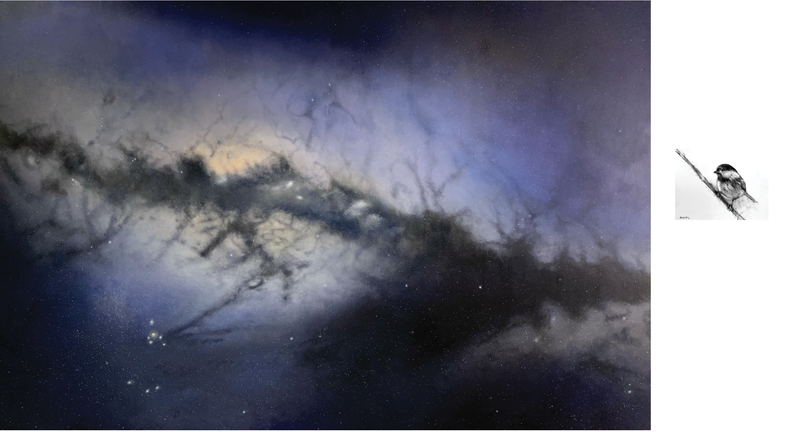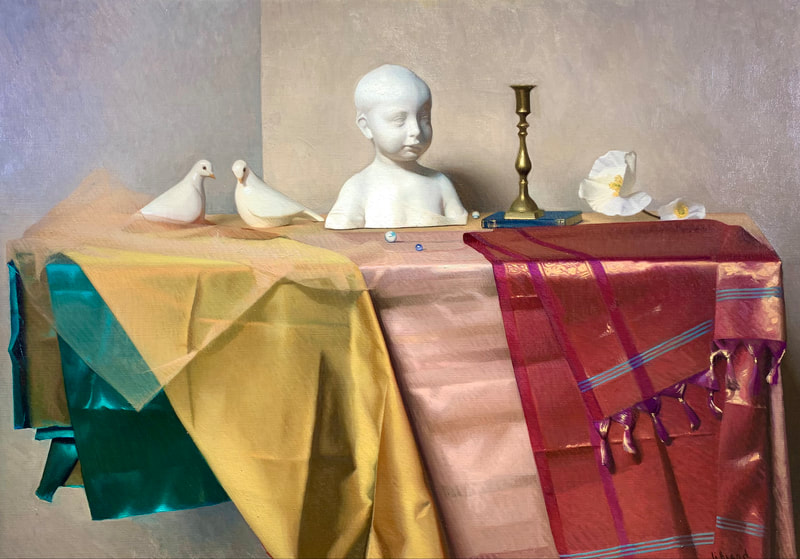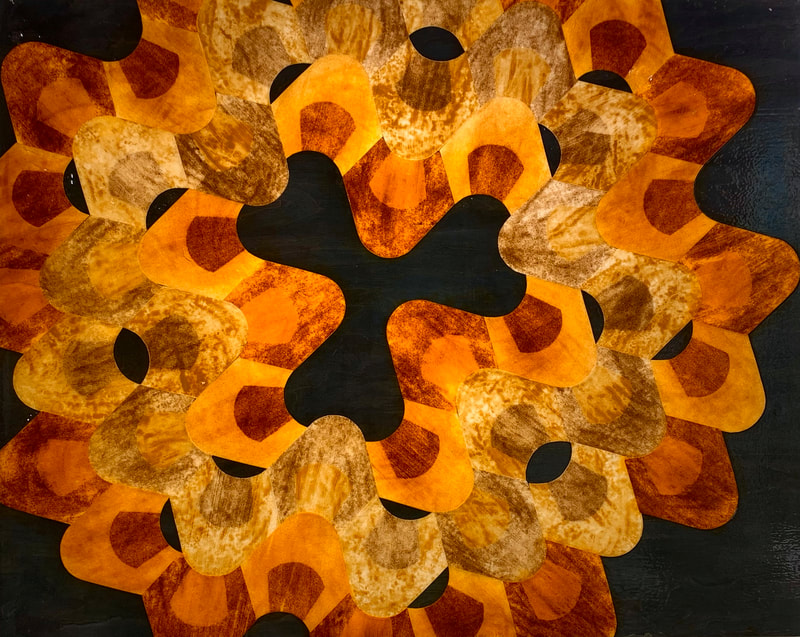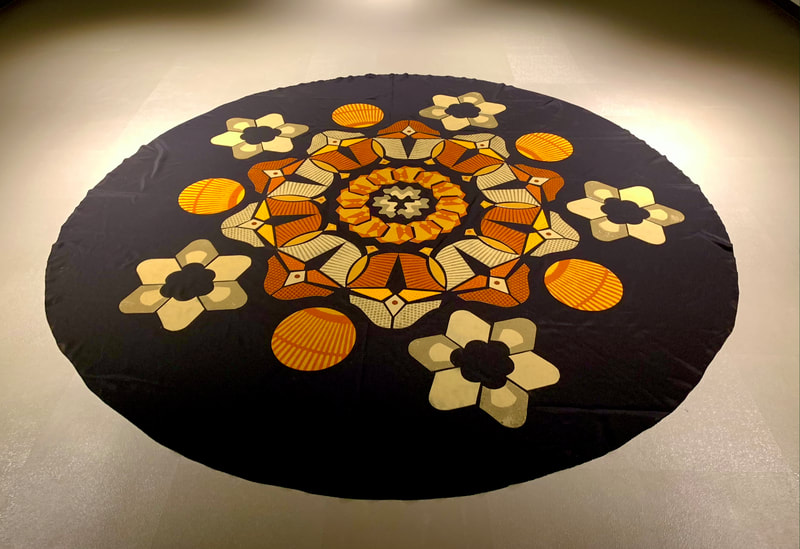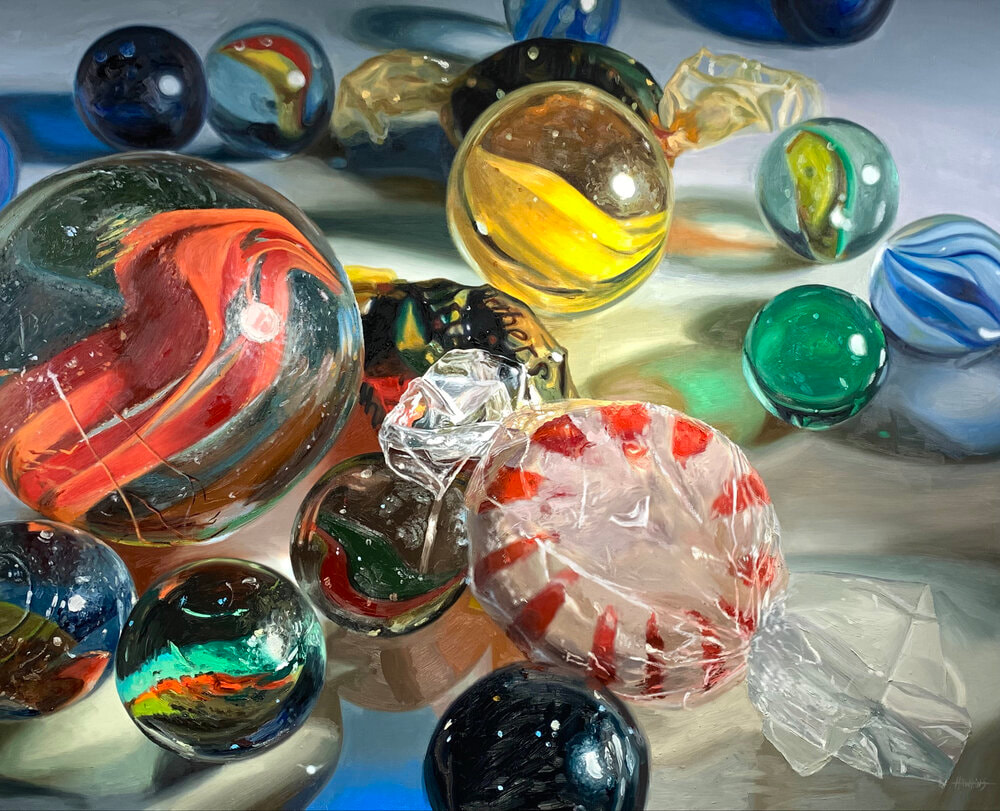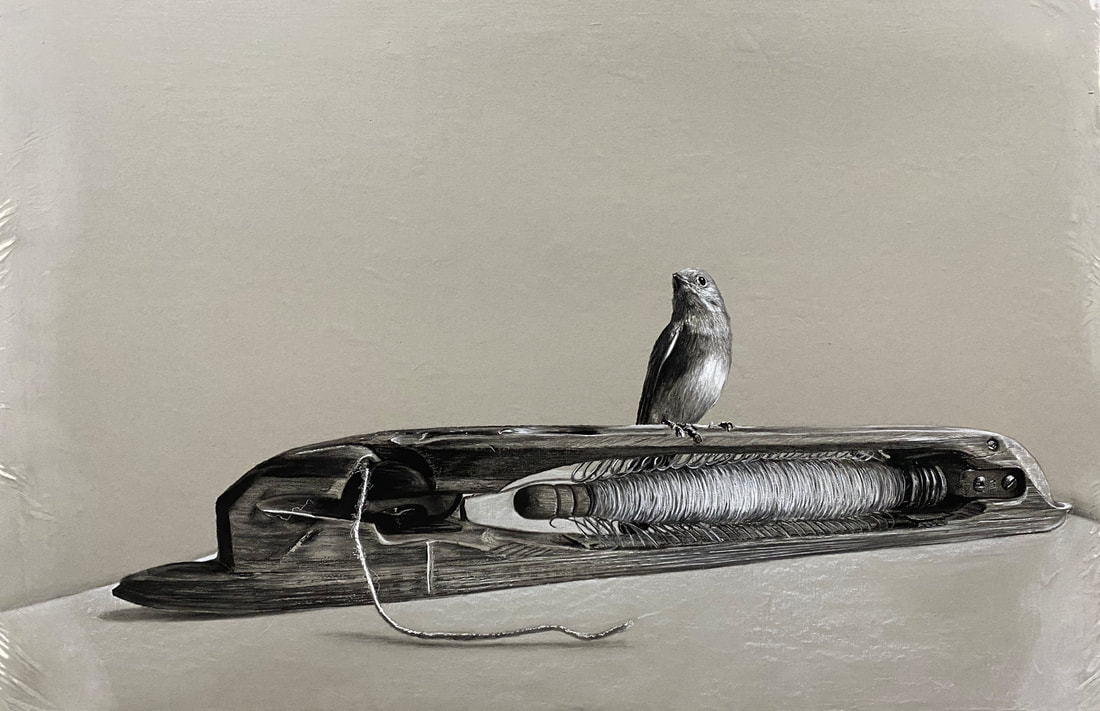|
|
seen.
“What Bach said of music will one day be seen as true of all of life. We will be re-created, and all the threads of our earthly life will come together for the design that we will experience in heaven. Every tribe, every language, every moment, every pain, and every sorrow will come together in the consummate pattern of God’s design.” — Ravi Zacharias (1946-2020) |
GALLERY STATEMENT
It is one of the first things that Ravi Zacharias told me about himself, though he wasn’t trying to say anything about himself at all: “F.W. Boreham is a writer who finds his way to the soul. He carefully draws a scene, invites readers to step inside it, and then he turns your attention to the God who is standing right there with you.”
The way he described F.W. Boreham became my first impression of Ravi Zacharias. His words clearly intended to champion a storyteller he loved, but he also handed me a vision for telling the greatest story, one he saw in Boreham and one by which he lived: We must tell the good news in such a way that its hearers are invited to inhabit it.
Ravi Zacharias’s presentation of the gospel was one that always arrived in spirit, in truth, and in color. He painted pictures for us with words, impressing truth upon the senses. His storytelling was always pastoral, his sentences offered in 3D. As I sit down to write anything, I always close my eyes, in the same way Ravi would to recite a poem, in order to see his visual, pastoral words come to life in my mind. His words found their way to people’s souls because Ravi described a scene he saw so clearly: For God so valued creation that he stepped into it—coming as one of us, speaking our language, inviting us to see the God who is standing right here with us.
In RZIM’s ministry to artists, one thing I have had the delight of hearing again and again is that Ravi spoke their language in such a way that made them feel seen and understood. Long before we had a gallery or a formal arts initiative, Ravi was speaking to the souls of artists not by offering proofs of the kingdom, but simply by depicting it well. He told the story of Jesus Christ in a manner that made it clear that this was a story in which we must participate. He described the house of God by turning on all of the lights, inviting people to come inside to taste and see the goodness for themselves. Christ so lived in the stories he told that it was an apologetic both thought and felt. Ravi was completely at home with the savior he described, and he invited his audiences to be at home as well.
The exhibit before you is a tribute to Ravi Zacharias and his artistic gift for depicting the gospel in vivid word and image. Each of the artists in this exhibit knew and loved him. Each one found their calling strengthened because they felt seen and valued in the Christian universe he so beautifully described. Together we chose a series of memorable stories, illustrations, and poetry that Ravi used throughout his ministry. As the artists gravitated toward particular illustrations, they also interacted with one another, resulting in a gallery of recurring symbols and interacting themes. Together they hold the paradox of the reeling pain of losing this voice too soon and the beauty of having heard it in the first place. Creation continues to groan in ways unlike anything most of us have ever witnessed in this season. Ravi’s cancer, Ravi’s death, all while hidden away in quarantined houses, is a groan so loud, yet too deep for words. How does one begin to sing the songs of hope and new creation in the midst of a creation that is groaning so loudly?
As I mourn the mentor who taught me those songs, as I lament with this country and its deep racial wounds, as I grieve lives and livelihoods lost to COVID-19, this question keeps repeating itself in my ears. More than ever, I am convinced that the arts are needed to answer this question, and that artists play a vital role demonstrating hope and new creation in the midst of this groaning world. Like Ravi, they remind us that we do not hope for naught, even in the dark when we labor to hold onto the light we once saw clearly. As Ravi once beautifully observed:
“What Bach said of music will one day be seen as true of all life. We will be re-created, and all the threads of our earthly life will come together for the design that we will experience in heaven. Every tribe, every language, every moment, every pain, and every sorrow will come together in the consummate pattern of God’s design.”
Each card in this exhibit offers an illustration of Ravi’s alongside the artist’s statement about the work created for this exhibition. There is also a QR code in the bottom corner of each card. When scanned with a smart phone, it links to a clip where you can hear Ravi tell the story. We hope you will feel as though you are walking around the gallery with Ravi himself, exploring hopeful signs of the presence of the Grand Weaver, of the Son who descends into our midst, and of the Spirit who reminds us to keep singing. May the LORD bless you and keep you.
Jill Carattini
@jillcarattini
The way he described F.W. Boreham became my first impression of Ravi Zacharias. His words clearly intended to champion a storyteller he loved, but he also handed me a vision for telling the greatest story, one he saw in Boreham and one by which he lived: We must tell the good news in such a way that its hearers are invited to inhabit it.
Ravi Zacharias’s presentation of the gospel was one that always arrived in spirit, in truth, and in color. He painted pictures for us with words, impressing truth upon the senses. His storytelling was always pastoral, his sentences offered in 3D. As I sit down to write anything, I always close my eyes, in the same way Ravi would to recite a poem, in order to see his visual, pastoral words come to life in my mind. His words found their way to people’s souls because Ravi described a scene he saw so clearly: For God so valued creation that he stepped into it—coming as one of us, speaking our language, inviting us to see the God who is standing right here with us.
In RZIM’s ministry to artists, one thing I have had the delight of hearing again and again is that Ravi spoke their language in such a way that made them feel seen and understood. Long before we had a gallery or a formal arts initiative, Ravi was speaking to the souls of artists not by offering proofs of the kingdom, but simply by depicting it well. He told the story of Jesus Christ in a manner that made it clear that this was a story in which we must participate. He described the house of God by turning on all of the lights, inviting people to come inside to taste and see the goodness for themselves. Christ so lived in the stories he told that it was an apologetic both thought and felt. Ravi was completely at home with the savior he described, and he invited his audiences to be at home as well.
The exhibit before you is a tribute to Ravi Zacharias and his artistic gift for depicting the gospel in vivid word and image. Each of the artists in this exhibit knew and loved him. Each one found their calling strengthened because they felt seen and valued in the Christian universe he so beautifully described. Together we chose a series of memorable stories, illustrations, and poetry that Ravi used throughout his ministry. As the artists gravitated toward particular illustrations, they also interacted with one another, resulting in a gallery of recurring symbols and interacting themes. Together they hold the paradox of the reeling pain of losing this voice too soon and the beauty of having heard it in the first place. Creation continues to groan in ways unlike anything most of us have ever witnessed in this season. Ravi’s cancer, Ravi’s death, all while hidden away in quarantined houses, is a groan so loud, yet too deep for words. How does one begin to sing the songs of hope and new creation in the midst of a creation that is groaning so loudly?
As I mourn the mentor who taught me those songs, as I lament with this country and its deep racial wounds, as I grieve lives and livelihoods lost to COVID-19, this question keeps repeating itself in my ears. More than ever, I am convinced that the arts are needed to answer this question, and that artists play a vital role demonstrating hope and new creation in the midst of this groaning world. Like Ravi, they remind us that we do not hope for naught, even in the dark when we labor to hold onto the light we once saw clearly. As Ravi once beautifully observed:
“What Bach said of music will one day be seen as true of all life. We will be re-created, and all the threads of our earthly life will come together for the design that we will experience in heaven. Every tribe, every language, every moment, every pain, and every sorrow will come together in the consummate pattern of God’s design.”
Each card in this exhibit offers an illustration of Ravi’s alongside the artist’s statement about the work created for this exhibition. There is also a QR code in the bottom corner of each card. When scanned with a smart phone, it links to a clip where you can hear Ravi tell the story. We hope you will feel as though you are walking around the gallery with Ravi himself, exploring hopeful signs of the presence of the Grand Weaver, of the Son who descends into our midst, and of the Spirit who reminds us to keep singing. May the LORD bless you and keep you.
Jill Carattini
@jillcarattini
Illustrations and Artist Statements
CRAIG HAWKINS, MARBLES & CANDY, OIL ON CANVAS, 60 X 48 INCHES, 2020.
|
The Marbles and the Candy
I heard a cute little story, growing up in India. It is the story of a brother and sister who had each started prized collections of their own. The little boy had a beautiful collection of marbles. But he was constantly eyeing his sister’s jar of carefully collected candy. One day he said to her, “If you give me all your candy, I’ll give you all of my marbles.” She gave it much thought, and finally agreed to the trade. He took all her candy and went back to his room to get his marbles. But the more he eyed them the more reluctant he became to give them all up. So he hid the best of them under his pillow and took the rest to her. That night, she slept soundly while he tossed and turned restlessly, unable to sleep and thinking, I wonder if she gave me all the candy? In the morning, the father sees his troubled son and invites him to talk about what is on his mind. The boy says, “I wonder if she really gave me all her candy.” The father, who knew what his son had done, replies, “May I ask if you gave your sister all of your marbles?” After a long silence, the boy admits that he has hidden some of the marbles from his sister. His dad smiles and asks him to go and make it right. But as his son is walking away, he adds, “What makes you think your sister has deceived you? Is it because you did not keep your promise to her that you began to doubt her word? My son, you must think carefully before you make a promise. And then, it is important to do what you promised.” The story offers an inviting metaphor. Christ gives us all of himself. Even now he extends his love to you completely, holding back nothing. Trust him with all of your heart, all of your soul, all of your mind, and all of your strength. Ravi Zacharias The Broken Promise |
Artist Statement:
It’s amazing how an inanimate object can remind us so much of life and those we love. Like a smell bringing forth a memory, it’s as if our presence leaves an imprint on things. The objects in this painting are just plain and simple pieces of a game or trade, but it’s in discovering the value of people we “play the game with” not “the game” that makes the game valuable. Ravi’s illustration of the marbles and candy strikes a chord with me not just because I have young kids and think it’s a perfect way to teach them the value of honesty but also because it presents the value of truth to me on a personal level. I have to confront my own commitment to truth before questioning someone else’s trustworthiness. I have to ask myself if I am holding onto anything that should be given to God. “Give all your worries and cares to God, because He cares about what happens to you” (1 Peter 5:7). In his telling of the gospel, Ravi Zacharias offered such a beautiful combination of a love for logic and a love for creative and cultivating acts. His writing, speaking, and care for poetry first convinced me that he deeply appreciated the arts and saw the arts as a vital component of presenting the beauty and truth of Christ. I have been awed by Ravi’s claim that the bridges to every listener ought never to be lost, and it has been remarkable to see how this pastoral vision included caring for artists and reaching out to speak to us in our own language. This painting depicts one of many memorable illustrations that have relational and personal applications of faith. Ravi’s love of language and his captivating ability to paint a picture with words will be deeply missed in the creative community. I long for my work to be this sort of bridge. Craig Hawkins @craighawkinsart |
CRAIG HAWKINS, TRIUNE HOPE, CHARCOAL ON PAPER, 31.5 X 49.5 INCHES, 2020.
|
The Candle and the Bird
I have drawn much comfort from an essay by the noted English writer F.W. Boreham. It is very beautifully titled “The Candle and the Bird.” Boreham makes the comment that God’s presence is more analogous to a bird than it is to a candle. When a candle is extinguished, the light goes out. But when a bird is driven away, it only leaves to sing its song on another bough. With that metaphor in mind Boreham traces the mighty moving of God throughout history. No, the light is never extinguished. As a bird, it has sung its song from different boughs. I am convinced that as dark as it may seem to us, there are strains of a melody beginning. The Lord of history may well be tuning his instruments as never before. Let us not look at the dark side. Boreham quotes poet Arthur Hugh Clough: …while the tired waves, vainly breaking, Seem here no painful inch to gain, Far back, through creeks and inlets making, Comes silent, flooding in, the main. And not by eastern windows only, When daylight comes, comes in the light, In front, the sun climbs slow, how slowly, But westward, look, the land is bright! The bird is singing its song. But the melody must first be sung in each of our hearts. The philosopher may debate. The skeptic may scoff. Experience may be deceptive. But the Word of God abides forever, and that Word has shone upon the face of our Lord Jesus Christ. We can rest in the confidence that the battle is not ours but belongs to God, our Holy Father, who was, who is, and who will be. Ravi Zacharias Cries of the Heart |
Artist Statement:
In the past I’ve been asked to draw a cardinal as a gift to a grieving family or friend with the loss of a loved one. In art history, birds often represent a soul or spirit, perhaps borrowing from the ultimate imagery of the Holy Spirit in scripture when the Spirit descends like a dove upon Jesus during his baptism as the Father speaks of his love for the Son. I don’t know when or how the symbolic nature of a bird began to be held as a comforting sign of the life of a loved one lost, its sudden appearance reminding and assuring us of the ongoing presence and care of a loved one. But I do know that grief has a way of inviting us to pay attention to life in new ways. And I think following Jesus’s prompt to “look at the birds” in Matthew 6:26-34 offers another glimpse of the Father’s empathy, provision, and love for us. Later, Jesus’s promise of the Holy Spirit as our comforter furthers this assuring hope of God’s care of every sparrow, of every loved one lost, of every child of the Father. The combination of images in this drawing is intentionally constructed to be Trinitarian, pulling from some of the recurring symbols in Ravi’s careful depictions of the good news. F.W. Boreham’s essay considering the Spirit as a songbird was an image in which Ravi found great hope. His encounter of the father and son on the loom in India offered another metaphor that made an indelible impression on his preaching. Father, Son, and Holy Spirit here each confront us in signs of comfort. The shuttle, the thread, and the bird have a triadic composition as well. For the bird, I chose a house sparrow, which is the state bird in Delhi and a nod to the general geographic location in Ravi’s illustration of the Grand Weaver. The light is never extinguished. The bird still sings. Craig Hawkins @craighawkinsart |
CRAIG HAWKINS, I KNEW IT NOT, CHARCOAL & GOLD LEAF ON PAPER, 30 X 43 INCHES, 2020.
|
A Slice of Infinity
I was unfamiliar with the work of F.W Boreham, whose essays compile over forty volumes, until I came to work for one of his chief enthusiasts. Owning every one of his essays, Ravi Zacharias read a chapter from one of his books every day, and credits him as an author who has written on his heart with indelible ink. F.W. Boreham tells a story he calls “A Slice of Infinity.” On the occasion that the local library was closing down, he had gone to town to inspect the vending of the books. What he found was a scheme intended to speed the selling: the books were tied up in lots of six—which would have been fine except that there seemed no pattern to the piles. Nonetheless, Boreham became the purchaser of half a dozen bundles that day, noting: “I had bought six books that I wanted, and thirty that I didn’t.” It was a motley crew. Many of them dealt with matters in which he had never taken the slightest interest. Yet hauling them away, he saw that the fault in this was entirely his. Boreham vowed that he would read all of them, and he did. Though he laughs at the odd manner of their first acquaintance, years later some of these works were among his favorite. “It was thus that I learned one of the most valuable lessons that experience ever taught me,” writes Boreham. “It is sometimes a fine thing to sample infinity.” It was with such an intention that A Slice of Infinity, one of Ravi’s early ministry initiatives, was given its name. First a radio program and later a creative writing resource, the intention was to offer glimpses of Christ beyond the places we might expect, ever cognizant that God’s table is a greater feast than we often see in front of us. At the close of his testimony, the Apostle John takes the time to point us even beyond the text itself: “Jesus did many other things as well. If every one of them were written down, I suppose that even the whole world would not have room for the books that would be written.” There were more stories to tell, other encounters to hear about, lives still unfolding at the hands of Christ. All of creation is being made new. We are at present only sampling infinity. Jill Carattini Sampling Infinity @24Caratt |
Artist Statement:
Preparing for this exhibit, I have been thinking about the story of Jacob’s ladder. I find it fascinating that Jacob’s response to his encounter with God was visual: he chose to create a stone marker to remember. It was a gesture meaningfully akin to our modern-day memorial stones and statues. There is also an overlap of heaven and earth in the story that I think is very rich. Jacob’s ladder is a reminder that God sends bridges, Christ himself being the perfect expression of this intention to bridge the heavens and the earth with the invitation that we might ascend. As a longtime reader of A Slice of Infinity and one inspired by Boreham’s story of the library, I envisioned gathering a large number of beloved books that left a mark over one’s life. I denote a setting apart of a chapter or two in each book by marking the perimeter of those pages in gold, each sliver or “slice” reflecting a golden light, a reminder that God is often nearer than we realize. It is a memorial of sorts both to Boreham’s experience of “sampling infinity” and to Jacob’s stone marker and his recognition that “Surely the Lord is in this place, and I knew it not.” The delineated golden chapter edges form a ladder ascending to the heavens. Held somewhere in the steps of this golden ladder is the mysterious balance between the formative moments of our lives—our decisions, our relationships, our acquiring of wisdom—and of God’s persisting and woven purposes through his sovereign will and grace within these moments, despite ourselves. These golden edges do not exist by themselves; they are not set in place at our own hands. Emboldened by the Spirit, the invitation to ascend originates not in the chapters of our lives or the pages of human wisdom but through the Son, by the Spirit, to the Father. The guiding shuttle that rests at the bottom of the composition signals Ravi’s illustration of the Grand Weaver. The ladder is Christ; it is also our means of ascending. It’s amazing to look back over time and recognize God’s hand inviting us ever nearer. Trust in God’s creative and beautiful bridge for the purpose of this life, God‘s grace given to us through his son, Jacob’s ladder. Craig Hawkins @craighawkinsart |

